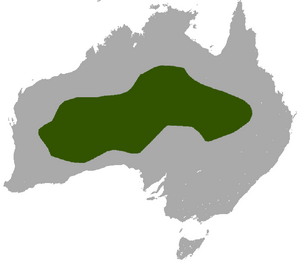Wongai ningaui facts for kids
Quick facts for kids Wongai ningaui |
|
|---|---|
| Conservation status | |
| Scientific classification | |
| Genus: |
Ningaui
|
| Species: |
ridei
|
 |
|
| Wongai ningaui range | |
The Wongai ningaui (scientific name: Ningaui ridei) is a super small, meat-eating marsupial. It lives in the dry, open grasslands of inland Australia. These tiny creatures mostly eat small insects. Sometimes, they also hunt bigger prey like spiders, grasshoppers, and cockroaches. They look for food on the ground and in clumps of a spiky grass called spinifex.
Wongai ningauis have long, messy fur that can be grey or reddish-brown with longer black hairs. They have small ears, a narrow snout, and a tail and feet that can help them climb. You can find them spread out over a large area, but they are more common in places with good rainfall. Scientists first officially described the Wongai ningaui in 1975.
Contents
About the Wongai Ningaui
Scientists gave the Wongai ningaui its official name, Ningaui ridei, in 1975. An Australian biologist named Mike Archer described it. He also described another similar species called the Pilbara ningaui.
The scientific name ridei honors an Australian naturalist named W. D. L. Ride. He helped scientists understand these small mammals better. The common name "Wongai ningaui" was officially recognized in 2001. Some people also call it "Ride's ningaui."
What Does It Look Like?
The Wongai ningaui is a very small animal. Its head and body together are about 5.8 to 7.5 centimeters (2.3 to 3 inches) long. Its tail is about 6 to 7 centimeters (2.4 to 2.8 inches) long. It weighs only about 6.5 to 10.5 grams, which is less than a small candy bar!
Its fur looks spiky and messy. It's mostly grey with some brown or reddish-brown hairs mixed in. It also has longer black hairs. Its ears are small and don't stick out much. It has small, close-set eyes and a pointy face. The sides of its head and lower ears might have a reddish-brown color. Its belly is whitish.
The Wongai ningaui is even smaller than a house mouse! It has a tail that can grip things a little. It also has very sharp, needle-like teeth and a long snout. The name ningaui comes from an Aboriginal word. It means tiny, hairy, mythological beings that have short feet and only come out at night.
Where Do They Live?
The Wongai ningaui lives mostly in the middle of Australia. They prefer areas with sand dunes or sandplains that have spinifex grass. They also live in grasslands with scattered trees like acacias, desert oaks, and mulga. You can find them from west of Kalgoorlie in Western Australia. Their home range stretches across northern South Australia and the southern Northern Territory to southwestern Queensland.
They are spread out, but you might find many of them in certain spots. If there isn't much rain in a year, their numbers can go down.
Behaviour and Life Cycle
The Wongai ningaui is a solitary animal, meaning it lives alone. It is also nocturnal, which means it is active at night. During the day, it rests in clumps of spinifex grass, inside a log, or in a small tunnel just under the ground.
They hunt for small invertebrates, mostly insects that are less than 1 centimeter (0.4 inches) long. But they can also catch bigger prey like spiders, grasshoppers, and cockroaches. If conditions are tough, like when there's not enough food or water, they can go into a special state called torpor. This is like a deep sleep that helps them save energy.
Female Wongai ningauis usually have five to seven babies at a time. They give birth between September and October. Sometimes, they can even have a second group of babies in the same year! The young stay in a nest until they are about six weeks old. They become independent when they are about thirteen weeks old. Only a few young ningauis survive to have their own babies the next year.
Conservation Status
The Wongai ningaui's conservation status was checked in 2015 by the IUCN Red List. They are listed as "least concern." This means their population is not likely to be decreasing, and they are not in danger of extinction.
You can find Wongai ningauis living in protected areas and nature reserves across parts of their home range. Authorities in Queensland and the Northern Territory also list this species as "least concern."


